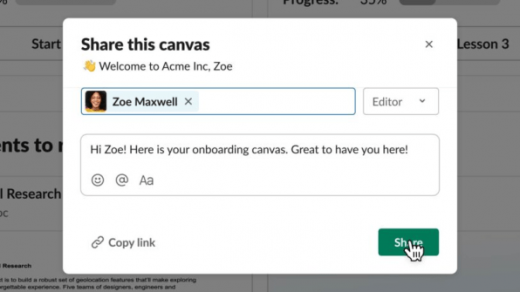Slack’s brand-new feature has an unexpectedly rich backstory
In the fall of 2014, Slack was the hottest startup in software. And that September, it went through a hot-startup rite of passage: It made its first acquisition.
The company it bought, Spaces, had only two employees. They’d built a tool for sharing text, links, images, and other items, which Slack saw as a useful extension of its core messaging platform. It was something like a word processor, but focused on collaboration rather than matching Microsoft Word’s kitchen-sink profusion of features.
“The pitch was like, people don’t really use documents as documents in the classic word processor lineage,” says Slack cofounder and CEO Stewart Butterfield. “They don’t need tab stops and page breaks and mail merge and stuff like that. They just want a digital container.”
Slack announced that it would roll Spaces into its own service and then . . . failed to do so. The acquisition “was a disaster, technologically,” says Butterfield. Over the following few years, the company occasionally returned to the idea of creating a flexible digital container for sharing items inside Slack, and each time the project fell apart.
Then something happened that suddenly made the goal seem feasible: In December 2020, Slack agreed to sell itself to Salesforce for $28 billion. That brought it under the same ownership as Quip, an innovative, collaborative productivity tool–acquired by Salesforce in 2016–that was in the same conceptual ZIP Code as Spaces had been.
[pullquote class=”topquote” cite=”Salesforce co-CEO/Quip cofounder Bret Taylor”]It does feel like the culmination of a lot of work that started in 2012.[/pullquote]Now Butterfield is getting the flexible container he’s wanted all along, based on Quip. Inside Slack, it’s a new feature known as Slack canvas that’s being previewed this week at Salesforce’s Dreamforce conference in San Francisco. After putting the added functionality through a pilot program with selected customers, Slack plans to make it generally available sometime in 2023.
(If the name “canvas” rings a bell, that might be because both Box and Monday.com have recently introduced white-boarding tools called Canvas. “Unfortunately, there are not that many names that are accurate,” says Butterfield.)
Rather than merely shoehorning Quip into Slack, canvas aims to “take those components that [Quip] had built and, and integrate them in a way that’s native to Slack,” says Chief Product Officer Tamar Yehoshua. “Not bolted on, but actually feeling like it would’ve been created from the ground up.” You can create canvases for any or all of your organization’s Slack channels, where they sit in the right pane for easy discovery; Yehoshua describes them as “a persistent layer of information.”
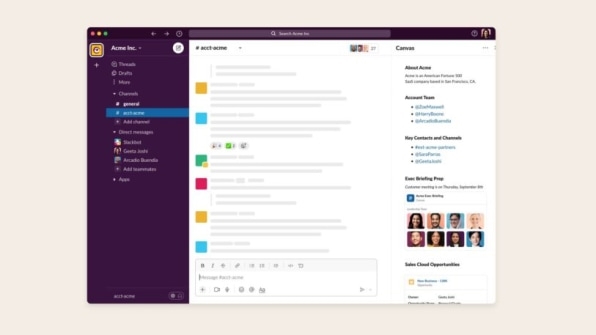
That persistence makes canvas fundamentally different from most of the features that have defined Slack until now. The conversations in Slack channels and DM sessions, for example, scroll away almost as fast as they occur. Slack’s huddles–audio (and now video) group calls for ad-hoc collaboration–are even more inherently ephemeral.
No matter how seriously Slack has taken its search features, it’s never excelled at the kind of teamwork that involves documenting something important, coming back to it again and again, and revising it as necessary. Canvas gives it a shot at changing that.
The arrival of canvas is also a meaningful moment for Quip. “It does feel like the culmination of a lot of work that started in 2012,” says Bret Taylor, who cofounded the startup that year, sold it to Salesforce four years later, and fared so well as a Salesforce employee that he is now the company’s co-CEO, sharing the job with Marc Benioff. (He’s also been in the news lately for his side job as Twitter’s chairman.)
Quip will continue to exist in standalone form and was already integrated into other Salesforce products, but by morphing into a Slack feature, it could reach far more people than it ever has on its own. Not that we know how big the two apps’ user bases are: Salesforce declines to provide such figures, saying that it’s more focused on engagement stats such as the 2.35 billion “actions” that happen in Slack each day.
Maybe it was destiny
Well before Slack and Quip were corporate siblings, it was obvious that their distinct approaches to workplace collaboration complemented each other. Starting in 2016, that fact had led to helpful integrations between the two apps. Then, in 2020, Taylor says, “Stewart actually called me and said, ‘Would you be willing to divest Quip from Salesforce and sell it to us at Slack?’ I think he already had a vision of what adding real-time document collaboration to Slack might mean.”
[pullquote]In its earliest days, Quip could be mistaken for an elegant yet relatively straightforward word processor.[/pullquote]Instead of Slack buying Quip, Butterfield’s proposal started the wheels spinning that led to Salesforce buying Slack. Managing the Quip team then became one of his responsibilities, a first step in bringing the two apps together.
In its earliest days, Quip could be mistaken for an elegant yet relatively straightforward word processor–or at least that’s what I took it to be when I first wrote about it. But its ambitions were always broader than that. And even though Slack canvas lets teams work together to assemble words, images, bulleted lists, and other elements into attractive layouts, that’s just the start.
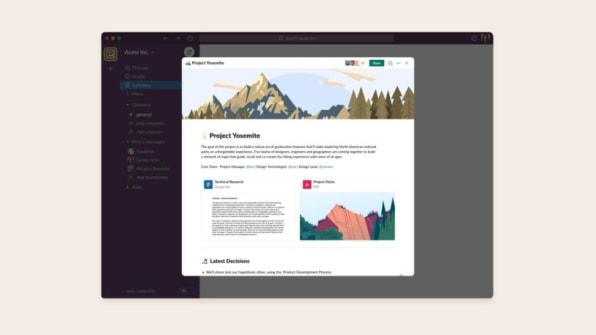
[Image: courtesy of Slack]
Butterfield references a real-world headache of his own by way of example. “When the Slack team switched to Salesforce laptops, there was, I’m not exaggerating, a 108-step setup process for laptops,” he says. “There were screenshots and a description of all the stuff that you have to do. It was like, ‘Go find this menu and then choose this option. And this check box has to be checked. And if you don’t do this thing after, then you have to go back and start over again.’”
Using Slack’s workflow builder and integrations with other services, a canvas could not only document such processes but automate them. “Imagine a new kind of onboarding document for a new employee that has them set up their banking information and insurance and request a new laptop and say if they have special ergonomic needs for their chair,” says Butterfield. “That kind of stuff as a document that has all the instructions, but also has interactive elements.”
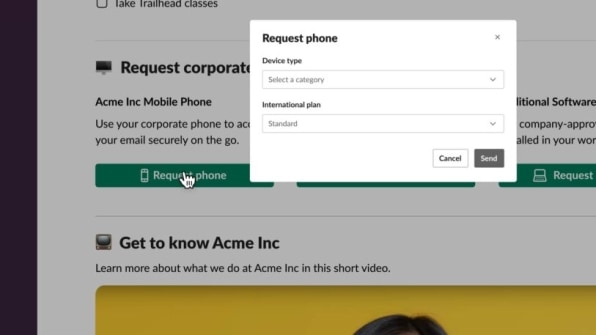
[Image: courtesy of Slack]
Yehoshua brings up similar potential uses: An organization could create a canvas that helps new employees request phones, watch training videos, and join a list of recommended Slack channels, then share it as part of the onboarding process. “What’s really nice is that a company can have a template for these and then use them for every new hire,” she says.
With its emphasis on internal communications and collaboration, Slack canvas isn’t a full-blown replacement for the likes of Word and Google Docs. But it does seem like the feature could solve a basic problem with using conventional documents as aids to vital work-related processes: It can be tough to remember where you stashed the relevant files. If an organization puts information in canvas, says Yehoshua, “it’s easier to find it. Everything will be searchable. And even if you are using Google Docs, you could link to your Google Docs from your canvas.”
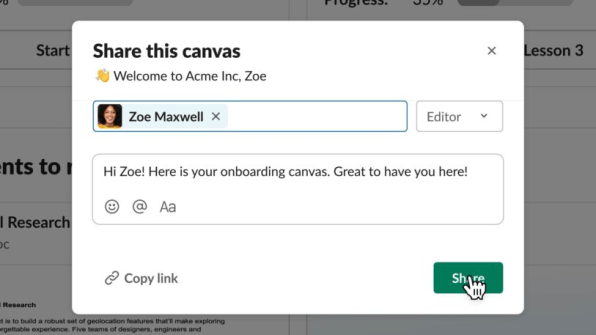
The future of a 10-year-old idea
As a broad concept, Slack canvas is not exactly without precedent. Butterfield credits Dropbox’s Paper, which has been exploring similar territory since 2015, as one inspiration. He adds that canvas’s emphasis on allowing organizations to collect and share important information gives it the spirit of a wiki: “It’s almost like every channel has its own wiki homepage.”
Meanwhile, newfangled collaborative editing environments such as Notion and Coda are riffing on the possibilities of infusing documents with app-like powers, putting them in at least vague proximity to what canvas is doing. As my colleague Jared Newman pointed out, even Microsoft and Google are dabbling with functionality along these lines.
Slack isn’t just hopping on a trendy bandwagon, though. The company is continuing the journey that Quip began a decade ago, well before the current boom in such products. By intermingling channels, huddles, and canvases, it’s building something distinct, with each feature helping to make the others more useful. There’s also room to expand canvas’s capabilities in the years to come: “It’s another surface that can continue to add value,” says Yehoshua.
Salesforce co-CEO/Quip cofounder Taylor says he’s excited to see where his decade-old brainchild goes in this new form. From now on, “when someone asks, ‘What’s the future of Quip?’, I have a real clear answer to that question,” he explains. “It’s going to be a part of Slack. And it’s awesome to see.”
(23)

